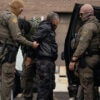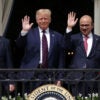AMERICA NEEDS A READY AND MODERNIZED FIGHTING FORCE
The President’s Budget
- The Obama Blueprint: While a robust starting point, the Obama budget blueprint fails to fully fund the core defense needs of the United States by about $30 billion in the base defense budget.
- Creates 10-Year Shortfall: The shortfall likely exceeds $1.3 trillion cumulatively over 10 years against the 4% of GDP benchmark identified as the cost to train, equip, and modernize America’s military for the next five to 10 years.
- Balanced Defense Program: Congress has sought to restore balance to the defense program by demanding an end to supplemental defense appropriations—such as $130 billion in war costs in this budget—and restoring the money to the core program. If pursued cautiously, this is the right approach.
The Military Needs Additional Resources
- Increasing Demand: Today’s reality is that the demand for U.S. military forces has increased significantly while the size of the force decreased in the 1990s. It is impossible for the military to support the efforts necessary to protect the American people, friends, and allies if the defense budget is not sustained at roughly today’s levels for 10 years.
- Current Strength: The Navy’s fleet has declined from 568 ships in the late 1980s to 276 in 2007. During Desert Storm, the Air Force had 37 fighter wing equivalents, but today they have just 20. The average age of aircraft in the Air Force has risen from nine years in 1973 to 24 years in 2007. Meanwhile, the Army is struggling to fund the Future Combat Systems, its most important vehicle- and communications-modernization program in over a generation.
- A Smaller Force: The past six years have shown that the Army needs to be large enough to sustain large-scale operations without having to deploy the same units multiple times or extend their deployments over the duration of the mission.
4% of GDP: A Small Price to Pay
- Inhofe–Franks Resolution: A joint congressional resolution introduced by Senator James Inhofe (R–OK) and Congressman Trent Franks (R–AZ) would commit 4% of the nation’s GDP to defense for 10 years.
Declining Funding: Defense spending has gradually declined as a percentage of GDP since the 1960s, while spending on major entitlements has continued to grow. - Alternative to the “Peace Dividend”: The wars in Afghanistan and Iraq occurred with a smaller peacetime force and were fought on a peacetime pre-9/11 budget, so there is no “peace dividend” to be had. The United States hasn’t mobilized its military to the appropriate levels since the Cold War.
- The Right Approach: The Inhofe–Franks proposal would allocate the resources necessary to protect the U.S., account for a wide spectrum of future missions, ensure adequate funding for ongoing operations, maintain a trained and ready all-volunteer military, and reform manpower and procurement policies.





























10 Replies to “The Growing Gap in Defense Spending”